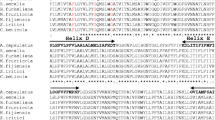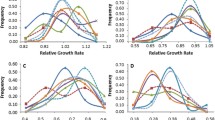Abstract
Ramularia collo-cygni (RCC) is a fungal pathogen infecting both spring and winter barley and causing Ramularia leaf spot (RLS). Fungicides based on strobilurin initially provided one of the best chemical solutions to manage the disease, but resistance in RCC to strobilurin developed quickly. In strobil-urin-resistant RCC isolates, a single point mutation is present in the cytochrome b gene. A population of 302 single-spore isolates of RCC, all collected in the Czech Republic in 2009, was analysed using a CAPS marker. The A143 (strobilurin resistant) allele was found in 47% of the isolates. Frequency of the mutant allele was significantly affected by the application frequency of strobilurin fungicides. In locations with more frequent application of strobilurins, the frequency of the allele A143 in RCC isolates was higher (up to 100%). By contrast, in locations where strobilurin fungicides were not used the mutant allele occurred only in 0-5% of the isolates.
Similar content being viewed by others
References
Amelung D, Sachs E & Huss H, 1999. Ramularia-Blattflecken-krankheit der Gerste — eine neue Krankheit in Deutschland. Getreidemagazin 99, 47.
Bartlett DW, Clough JM, Godwin JR, Hall AA, Hamer M & Parr-Dobrzanski B, 2002. The strobilurin fungicides. Pest Manag Sci 58, 649–662.
Brönimann A, 1988. Tätigkeitsbericht über die Jahre 1986 und 1987 aus der Eidg. Forschungsanstalt für Landw. Pflanzenbau Zürich-Reckenholz, p. 199.
Caron D, 2003. La ramulariose, nouvelle maladie de l’orge en France, Tours, France, AFPP septieme conference internationale sur les maladies des plantes, 3–5 December 2003.
Cavara F, 1893. Über einige parasitische Pilze auf dem Getreide. Zeitschrift für Pflanzenkrankheiten 3, 16–26.
Christiansen A, Jørgensen LN, Tiedemann von A, Balz T, Liebermann B & Miethbauer S, 2009. Fungicide impact on yield and Ramularia leaf spot, fungal biomass and rubellins. In: Oxley S, Brown J, Foster V V & Havis N (Eds.) 2009: The Second European Ramularia Workshop. 7–8 April, 2009, Edinburgh, Scotland. Aspect. Appl. Biol. 92, 33–39.
Cromey MG, Harvey IC, Sheridan EJ & Grbavag N, 2004. Occurrence, importance and control of Ramularia collo-cygni in New Zealand. In: Yahyaoui AH, Brader L, Tekauz A, Wallwork H & Steffenson B (Eds.) 2002: Proceedings of the Second International Workshop on Barley Leaf Blights, 7–11 April 2002, Aleppo, Syria, ICARDA, 337–342.
Djurle A & Rasmussen M, 2006. Ramularia leaf spot in barley. A new disease in Sweden? In: Koopman B, Oxley S, Schützendübel A & Tiedemann von A (Eds.) 2006: Proceedings of the First European Ramularia Workshop, Georg-August University Göttingen, Germany, March 2006, p. 16.
Fountaine J & Fraaije BA, 2009. Development of QoI resistant alleles in populations of Ramularia collo-cygni. In: Oxley S, Brown J, Foster VV & Havis N (Eds.) 2009: The Second European Ramularia Workshop. 7–8 April, 2009, Edinburgh, Scotland. Aspect Appl Biol 92, 123–126.
Fraaije BA, Cools HJ, Fountaine J, Lovell DJ, Motteram J, West JS & Lucas JA, 2005. Role of ascospores in further spread of QoI-resistant cytochrome b alleles (G143A) in field populations of Mycosphaerella graminicola. Phytopathology 95, 933–941.
Gisi U, Sierotzki H, Cook A & McCaffery A, 2002. Mechanisms influencing the evolution of resistance to Qo inhibitor fun-gicides. Pest Manag Sci 58, 859–862.
Gubis J, Hudcovicova M & Klcova L, 2008. First report of Ramularia collo-cygni in Slovakia. J Plant Pathol 90, 149.
Huss H, Mayerhofer H & Wetching W, 1987. Ophiocladium hordei CAV. (Fungi imperfecti), ein für Österreich neuer parasitärer Pilz der Gerste. Der Pflanzenarzt 40, 167–169.
Ishii H, Fraajie BA, Sugiyama T, Noguchi K, Nishimura K, Takeda T, Amano T & Hollomon DW, 2001. Occurrence and molecular characterization of strobilurin resistance in cucumber powdery and downy mildew. Phytopathology 91, 1166–1171.
Jørgensen LN & Christiansen A, 2007. Control of Ramularia in winter barley and spring barley using different fungicides — experiences from Denmark. In: Koopman B, Oxley S, Schützendübel A & Tiedemann von A (Eds.) 2006: Proceedings of the First European Ramularia Workshop, Georg-August University Göttingen, Germany, March 2006, 113–119.
Ma Z, Felts D & Michailides TJ, 2003. Resistance to strobilurin in Alternaria isolates from pistachio in California. Pestic. Biochem. Phys. 77, 66–74.
McCabe T, 2009. Fungicide strategies for the control of Ramularia collo-cygni to optimize grain yield and quality on spring barley in Ireland. In: Oxley S, Brown J, Foster VV & Havis N (Eds.) 2009: The Second European Ramularia Workshop. 7–8 April, 2009, Edinburgh, Scotland. Aspect Appl Biol 92, 133–136.
O’Sullivan E, 2004. Ramularia collo-cygni — a new pathogen associated with spotting of barley in Ireland. In: Yahyaoui AH, Brader L, Tekauz A, Wallwork H & Steffenson B (Eds.) 2002: Proceedings of the Second International Workshop on Barley Leaf Blights, 7–11 April 2002, Aleppo, Syria, ICARDA, 385–390.
Oxley SJP, Havis ND, Sutherland KG & Nutall M, 2002. Development of a rationale to identify the causal agent of necrotic lesions in spring barley and to identify control mechanisms. HGCA Project Report No. 282, HGCA Publications, London.
Pinnschmidt HO, Sindberg SA & Willas J, 2006. Expression of Ramularia leaf spot resistance in barley cultivars and its relation to resistance against other diseases. In: Turkington TK, Orr D & Xi K (Eds.): Proceedings of the Third International Workshop on Barley Leaf Blights, Edmonton, Canada, July 2006, pp. 141–145.
Sachs E, Amelung D & Klappach K, 1998. Die Symptome der Netzfleckenkrankheit der Gerste hervorgerufen durch Drechslera teres (Sacc.) Shoem. und deren Verwechslungsmöglichkeiten. Nachrichtenbl Deut Pflanzenschutz 50, 58–63.
Sachs E, 2002. Monitoring zur Verbreitung der Ramularia-Blattfleckenkrankheit an Wintergerste in Deutschland im Jahr 2000. Nachrichtenbl. Deut. Pflanzenschutz 54, 31–35.
Salamati S, 2004. Occurence of Ramularia collo-cygni on spring barley in Norway. In: Yahyaoui AH, Brader L, Tekauz A, Wallwork H & Steffenson B (Eds.) 2002: Proceedings of the Second International Workshop on Barley Leaf Blights, 7–11 April 2002, Aleppo, Syria, ICARDA, 355–359.
Sheridan JE, 2000. Cereal diseases 1999–2000 (Including peas and gooseberry mildew). Disease survey and disease control in the Wairarapa, New Zealand. Mycol. Plant. Path. Rep. No. 37, Botany Department, Victoria University of Wellington, New Zealand.
Sierotzki H, Wullschleger J & Gisi U, 2000a. Point-mutation in cytochrome b gene conferring resistance to strobilurin fungicides in Erysiphe graminis f.sp. tritici field isolates. Pestic. Biochem. Phys. 68, 107–112.
Sierotzki H, Parisis S, Steinfeld U, Tenzer I, Poirey S & Gisi U, 2000b. Mode of resistance to respiration inhibitors at the cytochrome bc1 enzyme complex of Mycosphaerella fijiensis field isolates. Pest Manag Sci 56, 833–841.
Sierotzki H, Frey R, Wullschleger J, Palermo S, Karlin S, Godwin J & Gisi U, 2007. Cytochrome b gene sequence and structure of Pyrenophora teres and P. tritici-repentis and implications for QoI resistance. Pest Manag Sci 63, 225–233.
Sutton BC & Waller JM, 1988. Taxonomy of Ophiocladium hordei, causing leaf lesions on Triticale and other Gramineae. Trans Br Mycol Soc 90, 55–61.
Untergasser A, Nijveen H, Rao X, Bisseling T, Geurts R & Leunissen JAM, 2007. Primer3Plus, an enhanced web interface to Primer3. Nucleic Acids Res 35, 71–74.
Author information
Authors and Affiliations
Rights and permissions
About this article
Cite this article
Matusinsky, P., Svobodova-Leisova, L., Mariks, P. et al. Frequency of a mutant allele of cytochrome b conferring resistance to Ool fungicides in the Czech population of Ramularia collo-cygni. J Plant Dis Prot 117, 248–252 (2010). https://doi.org/10.1007/BF03356369
Received:
Accepted:
Published:
Issue Date:
DOI: https://doi.org/10.1007/BF03356369




